Muzhi Li
Retrieval, Reasoning, Re-ranking: A Context-Enriched Framework for Knowledge Graph Completion
Nov 12, 2024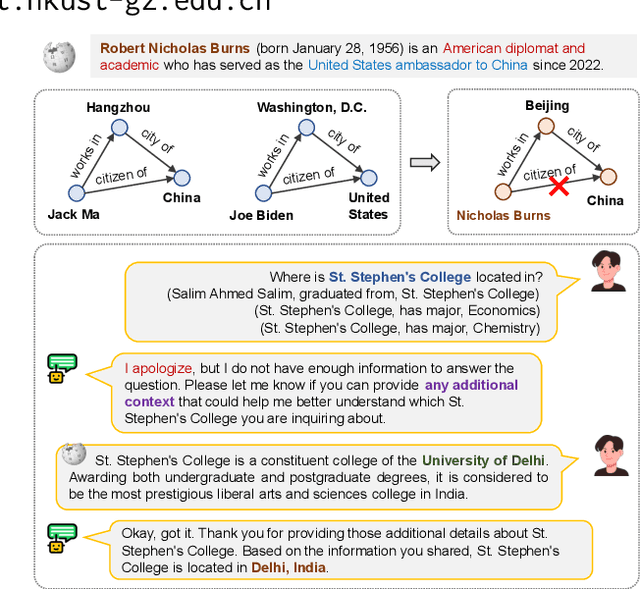
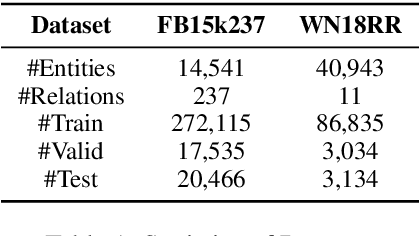
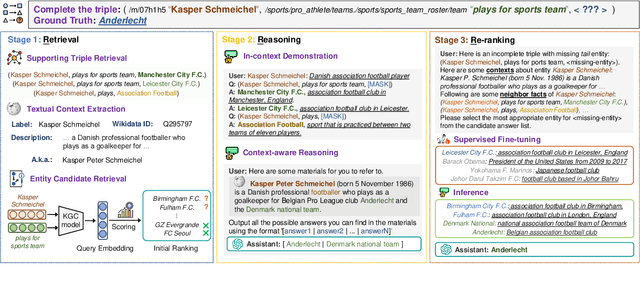
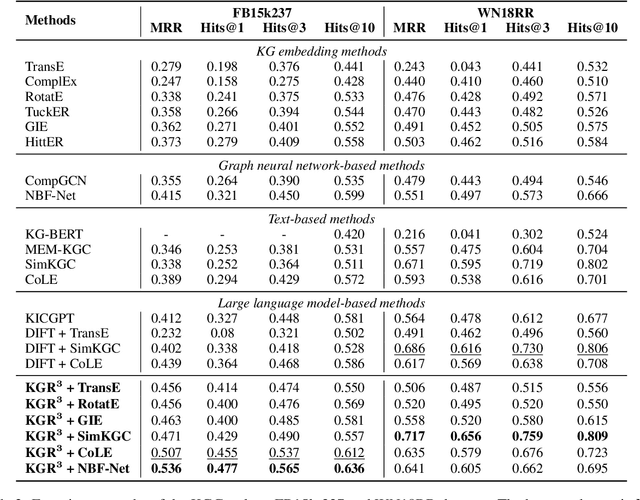
Abstract:The Knowledge Graph Completion~(KGC) task aims to infer the missing entity from an incomplete triple. Existing embedding-based methods rely solely on triples in the KG, which is vulnerable to specious relation patterns and long-tail entities. On the other hand, text-based methods struggle with the semantic gap between KG triples and natural language. Apart from triples, entity contexts (e.g., labels, descriptions, aliases) also play a significant role in augmenting KGs. To address these limitations, we propose KGR3, a context-enriched framework for KGC. KGR3 is composed of three modules. Firstly, the Retrieval module gathers supporting triples from the KG, collects plausible candidate answers from a base embedding model, and retrieves context for each related entity. Then, the Reasoning module employs a large language model to generate potential answers for each query triple. Finally, the Re-ranking module combines candidate answers from the two modules mentioned above, and fine-tunes an LLM to provide the best answer. Extensive experiments on widely used datasets demonstrate that KGR3 consistently improves various KGC methods. Specifically, the best variant of KGR3 achieves absolute Hits@1 improvements of 12.3% and 5.6% on the FB15k237 and WN18RR datasets.
Context-aware Inductive Knowledge Graph Completion with Latent Type Constraints and Subgraph Reasoning
Oct 22, 2024



Abstract:Inductive knowledge graph completion (KGC) aims to predict missing triples with unseen entities. Recent works focus on modeling reasoning paths between the head and tail entity as direct supporting evidence. However, these methods depend heavily on the existence and quality of reasoning paths, which limits their general applicability in different scenarios. In addition, we observe that latent type constraints and neighboring facts inherent in KGs are also vital in inferring missing triples. To effectively utilize all useful information in KGs, we introduce CATS, a novel context-aware inductive KGC solution. With sufficient guidance from proper prompts and supervised fine-tuning, CATS activates the strong semantic understanding and reasoning capabilities of large language models to assess the existence of query triples, which consist of two modules. First, the type-aware reasoning module evaluates whether the candidate entity matches the latent entity type as required by the query relation. Then, the subgraph reasoning module selects relevant reasoning paths and neighboring facts, and evaluates their correlation to the query triple. Experiment results on three widely used datasets demonstrate that CATS significantly outperforms state-of-the-art methods in 16 out of 18 transductive, inductive, and few-shot settings with an average absolute MRR improvement of 7.2%.
Think-on-Graph 2.0: Deep and Interpretable Large Language Model Reasoning with Knowledge Graph-guided Retrieval
Jul 15, 2024



Abstract:Retrieval-augmented generation (RAG) has significantly advanced large language models (LLMs) by enabling dynamic information retrieval to mitigate knowledge gaps and hallucinations in generated content. However, these systems often falter with complex reasoning and consistency across diverse queries. In this work, we present Think-on-Graph 2.0, an enhanced RAG framework that aligns questions with the knowledge graph and uses it as a navigational tool, which deepens and refines the RAG paradigm for information collection and integration. The KG-guided navigation fosters deep and long-range associations to uphold logical consistency and optimize the scope of retrieval for precision and interoperability. In conjunction, factual consistency can be better ensured through semantic similarity guided by precise directives. ToG${2.0}$ not only improves the accuracy and reliability of LLMs' responses but also demonstrates the potential of hybrid structured knowledge systems to significantly advance LLM reasoning, aligning it closer to human-like performance. We conducted extensive experiments on four public datasets to demonstrate the advantages of our method compared to the baseline.
Context Graph
Jun 28, 2024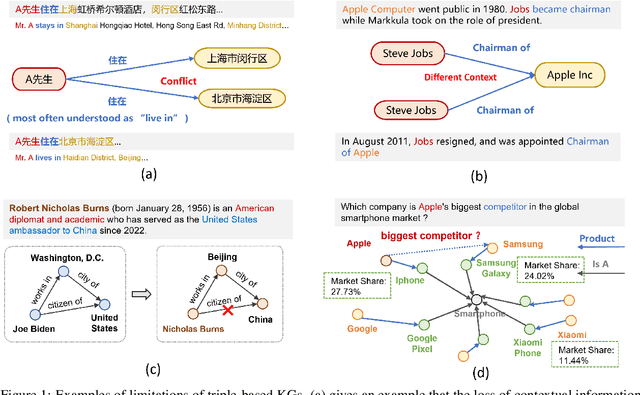
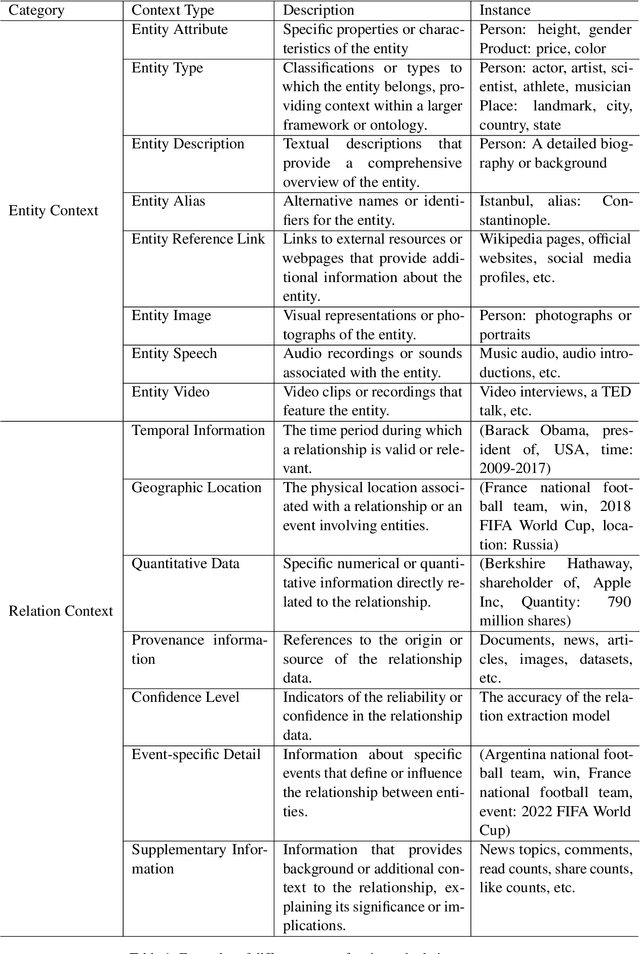
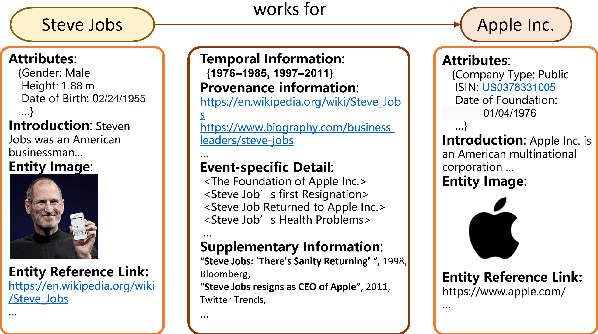
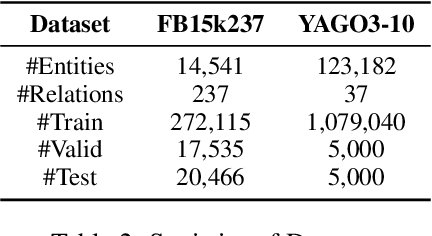
Abstract:Knowledge Graphs (KGs) are foundational structures in many AI applications, representing entities and their interrelations through triples. However, triple-based KGs lack the contextual information of relational knowledge, like temporal dynamics and provenance details, which are crucial for comprehensive knowledge representation and effective reasoning. Instead, \textbf{Context Graphs} (CGs) expand upon the conventional structure by incorporating additional information such as time validity, geographic location, and source provenance. This integration provides a more nuanced and accurate understanding of knowledge, enabling KGs to offer richer insights and support more sophisticated reasoning processes. In this work, we first discuss the inherent limitations of triple-based KGs and introduce the concept of CGs, highlighting their advantages in knowledge representation and reasoning. We then present a context graph reasoning \textbf{CGR$^3$} paradigm that leverages large language models (LLMs) to retrieve candidate entities and related contexts, rank them based on the retrieved information, and reason whether sufficient information has been obtained to answer a query. Our experimental results demonstrate that CGR$^3$ significantly improves performance on KG completion (KGC) and KG question answering (KGQA) tasks, validating the effectiveness of incorporating contextual information on KG representation and reasoning.
Contextual Knowledge Graph
Jun 21, 2024



Abstract:Knowledge Graphs (KGs) are foundational structures in many AI applications, representing entities and their interrelations through triples. However, triple-based KGs lack the contextual information of relational knowledge, like temporal dynamics and provenance details, which are crucial for comprehensive knowledge representation and effective reasoning. Instead, \textbf{Contextual Knowledge Graphs} (CKGs) expand upon the conventional structure by incorporating additional information such as time validity, geographic location, and source provenance. This integration provides a more nuanced and accurate understanding of knowledge, enabling KGs to offer richer insights and support more sophisticated reasoning processes. In this work, we first discuss the inherent limitations of triple-based KGs and introduce the concept of contextual KGs, highlighting their advantages in knowledge representation and reasoning. We then present \textbf{KGR$^3$, a context-enriched KG reasoning paradigm} that leverages large language models (LLMs) to retrieve candidate entities and related contexts, rank them based on the retrieved information, and reason whether sufficient information has been obtained to answer a query. Our experimental results demonstrate that KGR$^3$ significantly improves performance on KG completion (KGC) and KG question answering (KGQA) tasks, validating the effectiveness of incorporating contextual information on KG representation and reasoning.
Move Beyond Triples: Contextual Knowledge Graph Representation and Reasoning
Jun 17, 2024



Abstract:Knowledge Graphs (KGs) are foundational structures in many AI applications, representing entities and their interrelations through triples. However, triple-based KGs lack the contextual information of relational knowledge, like temporal dynamics and provenance details, which are crucial for comprehensive knowledge representation and effective reasoning. Instead, \textbf{Contextual Knowledge Graphs} (CKGs) expand upon the conventional structure by incorporating additional information such as time validity, geographic location, and source provenance. This integration provides a more nuanced and accurate understanding of knowledge, enabling KGs to offer richer insights and support more sophisticated reasoning processes. In this work, we first discuss the inherent limitations of triple-based KGs and introduce the concept of contextual KGs, highlighting their advantages in knowledge representation and reasoning. We then present \textbf{KGR$^3$, a context-enriched KG reasoning paradigm} that leverages large language models (LLMs) to retrieve candidate entities and related contexts, rank them based on the retrieved information, and reason whether sufficient information has been obtained to answer a query. Our experimental results demonstrate that KGR$^3$ significantly improves performance on KG completion (KGC) and KG question answering (KGQA) tasks, validating the effectiveness of incorporating contextual information on KG representation and reasoning.
The Integration of Semantic and Structural Knowledge in Knowledge Graph Entity Typing
Apr 12, 2024Abstract:The Knowledge Graph Entity Typing (KGET) task aims to predict missing type annotations for entities in knowledge graphs. Recent works only utilize the \textit{\textbf{structural knowledge}} in the local neighborhood of entities, disregarding \textit{\textbf{semantic knowledge}} in the textual representations of entities, relations, and types that are also crucial for type inference. Additionally, we observe that the interaction between semantic and structural knowledge can be utilized to address the false-negative problem. In this paper, we propose a novel \textbf{\underline{S}}emantic and \textbf{\underline{S}}tructure-aware KG \textbf{\underline{E}}ntity \textbf{\underline{T}}yping~{(SSET)} framework, which is composed of three modules. First, the \textit{Semantic Knowledge Encoding} module encodes factual knowledge in the KG with a Masked Entity Typing task. Then, the \textit{Structural Knowledge Aggregation} module aggregates knowledge from the multi-hop neighborhood of entities to infer missing types. Finally, the \textit{Unsupervised Type Re-ranking} module utilizes the inference results from the two models above to generate type predictions that are robust to false-negative samples. Extensive experiments show that SSET significantly outperforms existing state-of-the-art methods.
Momentum Contrastive Pre-training for Question Answering
Dec 12, 2022Abstract:Existing pre-training methods for extractive Question Answering (QA) generate cloze-like queries different from natural questions in syntax structure, which could overfit pre-trained models to simple keyword matching. In order to address this problem, we propose a novel Momentum Contrastive pRe-training fOr queStion anSwering (MCROSS) method for extractive QA. Specifically, MCROSS introduces a momentum contrastive learning framework to align the answer probability between cloze-like and natural query-passage sample pairs. Hence, the pre-trained models can better transfer the knowledge learned in cloze-like samples to answering natural questions. Experimental results on three benchmarking QA datasets show that our method achieves noticeable improvement compared with all baselines in both supervised and zero-shot scenarios.
 Add to Chrome
Add to Chrome Add to Firefox
Add to Firefox Add to Edge
Add to Edge